| | Factsheet topics | Feed requirements for overwintering beef cows | Nutritional values of grass seed straw | Grass seed straw for feed | Protein versus energy supplementation | Body condition score management | Nutritional value of post-harvest re-growth | Endophytes
One method of lowering winter feeding costs in areas where grass seed is grown is to use grass seed residues (such as straw and fall re-growth) for livestock feed.
Grass seed residue can be plentiful where available (Figure 1). It is standard practice for growers to remove grass seed straw after seed harvest, as doing so helps improve seed yields the following year.
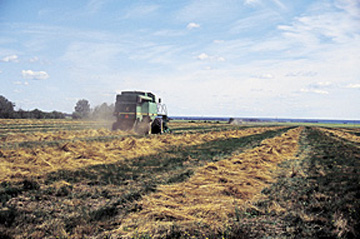
Figure 1. Grass seed field following harvest.
In addition, some species (including creeping red fescue, meadow bromegrass and tall fescue) may provide an opportunity for late haying or grazing if enough material is present (Figure 2).
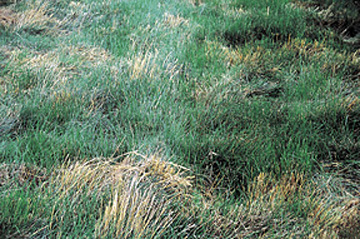
Figure 2. Re-growth in a grass seed field in the fall.
Although making use of grass seed residues is not a new concept to livestock producers, most of the by-products from the grass seed industry continue to be underused. One use of these residues is as livestock feed. A recent survey on the feed quality of grass seed residue confirmed that perennial grass seed straws have specific benefits:
- better quality feed than cereal straws
- higher in feed quality than generally believed
While grass seed straw can be an effective feed source for overwintering beef cows, livestock must be in good condition before winter and may require supplementation.
Factsheet Topics:
- feed requirements for overwintering beef cows
- nutritional values of grass seed straw
- grass seed straw for feed
- protein versus energy supplementation
- body condition score management of beef cows
- nutritional value of post-harvest re-growth
- endophytes
Feed Requirements for Overwintering Beef Cows
Grass seed straw is a low-cost feed alternative for beef cattle. Due to the variability and often lower than average feed value of the straws, it is best suited as feed for mature dry cows that are in the second to early third trimester.
For example, maintaining a 1,350 lb mature beef cow that is in a good-to-better body condition of at least a 6 (scale 1-9) will require a minimum of 6.5 per cent crude protein (CP) and 50 per cent total digestible nutrients (TDN) for maintenance (Table 1).
| Table 1. Energy and protein requirements for a 1,350 lb beef cow at various stages of gestation (National Research Council, 1996) |
 | Protein % | ADF % | TDN % | DE Mcal/kg |
| Cow-mid pregnancy | 6.5 | 59 | 50 | 2.2 |
| Cow-late pregnancy | 7.5 | 50 | 54 | 2.4 |
| Cow-lactation/early milk | 10 | 45 | 58 | 2.9 |
| Cow-lactation/peak milk | 11 | 40 | 63 | 3.1 |
As the cow approaches late pregnancy (the last six weeks prior to calving), protein and energy needs increase to
7.5 per cent CP and 54 per cent TDN. Postpartum CP levels and energy values then rise again to meet the requirements for milk production and for recuperation from the demands of pregnancy.
Winter feeding programs should be designed so that cows either maintain their weight or lose some excess. Cows should be gaining their weight in the summer and fall when pastures are high in feed value and climate conditions are good.
Nutritional Values of Grass Seed Straw
A recent survey had grass seed straw samples of different species being collected from a number of fields throughout the Peace River Region over the four-year period from 2001 to 2004. The samples were then analyzed for feed quality. Results:
- All grass seed straws had higher average nutritional values than cereal straws (Table 2).
- Tall fescue straw is one of the higher-quality grass seed straws that can be fed, having a similar feed value to grass hay.
- In general, turf-type grass species such as tall fescue or creeping red fescue have better feed qualities than hay or pasture-type grass species.
| Table 2. Nutritional values of cereal straws, hay and grass seed residues |
 | Feed source | Protein % | ADF % | TDN % | DEM cal/kg |
| Cereal straw | Barley straw | 4.6 | 46 | 47 | 2.05 |
 | Wheat straw | 4.0 | 50 | 41 | 1.80 |
 | Oat straw | 4.3 | 46 | 49 | 2.16 |
| Hay | Alfalfa/brome hay | 14.0 | 34 | 61 | 2.69 |
 | Alfalfa/hay | 18.2 | 28 | 64 | 2.81 |
| Grass residue | Meadow bromegrass | 6.6 | 42 | 52 | 2.30 |
 | Tall fescue | 8.4 | 40 | 56 | 2.49 |
 | Creeping red fescue | 6.9 | 43 | 51 | 2.25 |
 | Timothy | 4.9 | 39 | 57 | 2.51 |
 | Smooth bromegrass | 5.4 | 38 | 58 | 2.54 |
 | Crested wheatgrass | 3.9 | 37 | 60 | 2.62 |
Survey results also showed a wide range in quality among the samples within each species (Tables 3, 4 and 5), as well as variation from year-to-year within the same field (Figures 4 and 5). A number of factors affect the feed value of grass seed straw:
- nitrogen fertility rates
- stand age
- seed yield of the crop
- swathing height - more stems than leaf blades
- conventional versus rotary combines
- weather conditions
- crop moisture and height - if the crop is short, as in the case of drought, there is a decrease in the residue tonnage but often an increase in its feed quality
| Table 3. Comparison of crude protein content (%) across grass seed residues |
| Species | # of samples | Average protein % | Range of protein % |
| Tall fescue | 31 | 8.4 | 5.3 - 12.8 |
| Creeping red fescue | 72 | 6.9 | 3.2 - 14.4 |
| Timothy | 38 | 4.9 | 2.1 - 9.7 |
| Meadow bromegrass | 34 | 6.6 | 4.1 - 9.9 |
| Smooth bromegrass | 14 | 5.4 | 3.8 - 8.2 |
| Crested wheatgrass | 2 | 3.9 | 3.5 - 4.3 |
.
| Table 4. Total digestible nutrient (TDN) comparison across grass seed residues |
| Species | # of samples | Average TDN % | Range of TDN % |
| Tall fescue | 31 | 56 | 49 - 71 |
| Creeping red fescue | 71 | 51 | 33 - 65 |
| Timothy | 37 | 57 | 44 - 69 |
| Meadow bromegrass | 34 | 52 | 42 - 64 |
| Smooth bromegrass | 13 | 58 | 48 - 64 |
| Crested wheatgrass | 2 | 60 | 59 - 61 |
.
| Table 5. Comparison of digestible energy (DE) content across grass seed residues |
| Species | # of samples | Average DE Mcal/kg | Range of DE Mcal/kg |
| Tall fescue | 31 | 2.49 | 1.88 - 3.33 |
| Creeping red fescue | 72 | 2.25 | 1.60 - 2.84 |
| Timothy | 38 | 2.51 | 1.94 - 3.05 |
| Meadow bromegrass | 34 | 2.3 | 1.86 - 2.81 |
| Smooth bromegrass | 14 | 2.54 | 2.09 - 2.81 |
| Crested wheatgrass | 2 | 2.62 | 2.58 - 2.66 |
These results emphasize the importance of both feed testing and ration balancing in maintaining optimal animal performance.
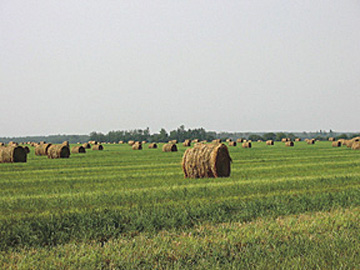
Figure 3. Fescue straw bales following seed harvest.
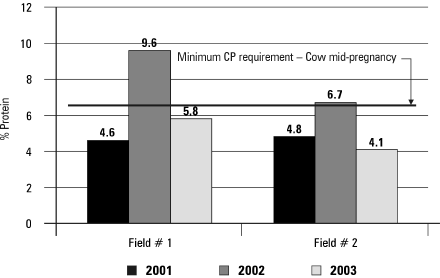
Figure 4. Variation in Crude Protein of timothy straw from two different fields over a three-year period.
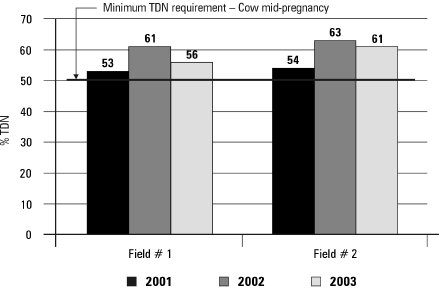
Figure 5. Variation in Total Digestible Nutrients of timothy straw from two different fields over a three-year period.
Grass Seed Straw for Feed
Depending on quality, grass seed straw can make up to 75 per cent or more of a wintering cow's diet (Figure 6). The amount of dry matter feed a cow will eat can be predicted based on feed quality:
- Cows eating good quality feed will ingest between 2.0 to 2.25 per cent of their body weight daily.
- Poor quality feed will be consumed at the rate of around 1.25 per cent of body weight daily.
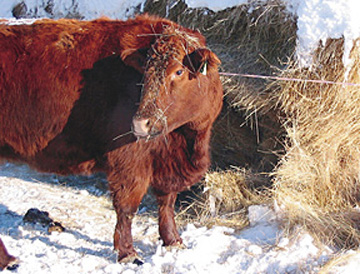
Figure 6. Feeding grass seed straw to cows.
Some factors to consider when feeding grass seed straw:
- Although crude protein levels and digestible energy levels generally decrease by 10 per cent during storage, cattle seem to have a preference for straw that has been stored for a year.
- Cattle digest poor quality, low protein (less than 6.5% CP) residues more slowly than they do average quality feed, which means they will eat less.
- Cattle will eat more straw if it is ground or processed. However, if the feed is not supplemented with the proper amounts of protein, then impaction, malnutrition and lowered conception rates can result.
A cow's intake decreases in the range of 12 to 13 per cent when she is in the latter stages of gestation. However, the capacity of the cow to take in the bulky feed is reduced due to the space that the developing calf occupies in her abdominal cavity. Once the cow approaches the end of her gestation cycle, it may become necessary to provide a more concentrated nutrient source by substituting a higher quality feed source for some of the grass seed straw.
Protein
The most important component to check when feeding grass seed straw is digestible crude protein (CP). Protein is the fuel that drives rumen function. It is broken down in the rumen to ruminal ammonia NH3, which is then used by the rumen micro flora to break down the fibrous component of the feed.
If feeds have CP levels below 6.5 percent, ruminal fermentation slows down and dry matter intake decreases. As such, supplementing low CP-level grass seed straw with protein has proven to be an effective way of improving dry matter intake and digestion. These supplements work by increasing the concentration of ruminal NH3 available for bacteria digestion. Increasing the NH3 levels in the rumen:
- reduces time for bacteria multiplication
- enhances the bacteria's ability to digest low quality roughage
The resulting enhanced throughput of the roughage results in an increase in dry matter intake and, subsequently, an increase in animal performance. Cows can more easily maintain their body weight and body condition if they get protein supplements.
Good sources of protein supplements for grass seed straw:
- better quality mixed grass hays
- barley silage
- alfalfa hay
- canola meal
- feed peas
Grass seed straws are maintenance rations and are not effective in increasing cow body condition. It is recommended that animals in poor condition be segregated from the herd and fed a higher energy ration so that proper body condition can be achieved.
Energy
Grass seed straw may sometimes have adequate CP levels for mid-gestation cows, but due to growing conditions or cutting height, the straw may be overly fibrous and have lower digestible energy values.
In such circumstances, it may be necessary to supplement the diet with an energy source such as lightly cracked barley or oats. Supplementing the diet with better quality roughages (such as good quality hay or silage) to balance out the two feed sources may be effective as well.
Minerals and vitamins
It is important for cows to receive adequate levels of minerals, vitamins and salt for them to produce efficiently and economically. Trace minerals should be provided as necessary to ensure the cows receive not only their calcium and phosphorus, but also other essential minerals such as copper and selenium. Depending upon what else is fed in the ration, a 1:1 mineral (equal proportions of calcium and phosphorus) will generally be enough.
A pre-calving cow's vitamin A requirement is 40,000 IU (international units) per day. This requirement increases to 70,000 IU of vitamin A per day post-calving. In addition, a mineral source with higher levels of vitamin E fed in the last six weeks pre-calving will help strengthen the cow's immune system.
Protein Versus Energy Supplementation
When comparing supplements to feed with grass seed residues, base the comparison on the cost per pound of the actual nutrients, that is, per pound of protein or energy.
Wheat, barley and oats can be excellent sources of energy to supplement grass seed straw; however, if the grass seed straw is lacking protein (<6.5 percent CP), it is the nutrient that needs to be supplemented first.
When crude protein levels of the grass seed straw are low, the high energy values of small grains can cause what is known as a negative associative effect. Rather than improving the dry matter intake and digestibility of low-quality roughages (a positive associative effect), energy supplements will substitute the dry matter intake and impair the digestion of low quality roughage.
If temperatures get colder and cattle have a sudden increase in the consumption of the grass seed straw, the negative associative effect can cause impaction of the rumen. This negative effect is generally not seen with medium to high quality forages because the protein levels are not limiting.
Body Condition Score Management
When feeding grass seed straw, target beef cows that are in good body condition at the beginning of the winter feeding period.
A winter-feeding trial was conducted in Alberta to look at the effect of fall body condition on the winter feed requirements of beef cows.
- In year one, 196 pregnant beef cows, in pens of four, were fed daily.
- In year two, 50 pregnant beef cows were housed in individual pens and fed every second day.
- In year three, 60 pregnant beef cows were housed in individual pens and were fed every second day.
In the fall of each year, the cows were weighed, body condition scored (BCS) on a scale from 1 to 5 and then placed on one of three feeding schedules:
- "thin" cows that had a BCS average of 2.25 over the three years were fed to gain condition
- "moderate" cows that had a BCS average of 3 over the three years were fed to maintain condition
- "fat" cows that had an average BCS of 3.6 over the three years were fed to lose condition
The feeding programs were set up to target a BCS at calving of 3 out of 5, which is the most productive BCS for a mature cow at calving. The trial lasted between 110 and 120 days each year, with the cows returning home for the April calving season. The results are shown in Table 6.
| Table 6. Physical summary (3-year average) |
 | Thin | Moderate | Fat |
| Start BCS | 2.3 | 3.01 | 3.64 |
| End BCS | 3 | 3.13 | 3.38 |
| Change | 0.7 | 0.12 | -0.26 |
| Start weight | 1,196 | 1,289 | 1,379 |
| End weight | 1,363 | 1,403 | 1,455 |
| Change (ADG) | +167
(1.46) | +114
(1.00) | 76
(0.68) |
| Start back fat (mm) | 2.37 | 4 | 7.13 |
| End back fat (mm) | 6.13 | 4.9 | 7 |
| Change | 3.76 | 0.9 | -0.13 |
The economic effects of this trial are shown in Table 7. The feed costs have been calculated on a per-cow per-day basis and adjusted to per 1,000 lbs of cow per day. This second calculation removes the variable of cow weight at the start of the trial, leaving body condition score as the only variable.
| Table 7. Ration summary (lbs DM/head/day) |
 | Year 1* | Year 2** | Year 3*** |
 | Straw | Silage | Straw | Silage | Barley | Silage | Barley |
| Thin | 7.88 | 16.94 | 4.1 | 18.6 | 3.83 | 17.37 | 10.83 |
| Moderate | 7.74 | 16.06 | 7.78 | 17.87 | 1.77 | 19.8 |  |
| Fat | 6.83 | 13.94 | 8.3 | 15.07 | 0.21 | 18.4 |  |
| Year 1* | Barley silage and barley straw fed daily. |
| Year 2** | Alfalfa/grass silage, barley straw and barley grain fed every second day. |
| Year 3*** | Baley silage, barley straw and barley grain fed every second day. |
The costs in Table 8 are shown using two sets of feed prices: from an average year and from a year of drought-induced feed prices.
| Table 8. Feed cost summary using average and drought feed prices |
 | $/cow/day | $/1,000 lbs of cow/day |
 | Average* | Drought** | Average* | Drought** |
| Thin (2.3) | 1.15 | 2.06 | 0.96 | 1.72 |
| Moderate (3) | 0.88 | 1.7 | 0.68 | 1.32 |
| Fat (3.6) | 0.75 | 1.47 | 0.55 | 1.07 |
| Cost to feed thin over fat | $0.40 | $0.59 | $0.41 | $0.65 |
| * | Average feed price: silage - $32/tonne as fed, straw - $32/tonne as fed, barley - $3/bus as fed. |
| ** | Drought feed prices: silage - $60/tonne as ffed, straw - $77/tonne as fed, barley - $4bus as fed. |
Using the difference in feed costs between the thin and fat cows during a drought year, one point of body condition score was worth $58 over a 115-day feeding period. For an average feed cost per year, one point of body condition score was worth $36 for the same 115-day period.
Over the three years, the thin cows required 26.5 lbs dry matter (DM) per day, whereas the fat cows only required 21 lbs DM per day. This is a difference of 5.5 lbs DM per day. In year three, where the difference in DM consumption was almost 10 lbs per cow per day, the fall body condition had a very significant effect on feed and roughage needs.
Recognizing and managing the fall body condition of beef cows can add value to any operation. Winter feed costs can vary significantly depending on the body condition of the cows in the fall. Cows that are fatter in the fall will cost less to feed over winter than thin cows and overwinter better than thin cows when fed grass seed straw.
Nutritional Value of Post-harvest Re-growth
If nitrogen and moisture conditions are adequate, a number of species (such as creeping red fescue, meadow bromegrass and tall fescue) will re-grow following seed harvest. If sufficient re-growth is present, the residue can be either removed as hay or grazed. The feed value of the fall re-growth is generally excellent (Tables 9, 10 and 11). Younger cattle (first and second calvers), which have greater nutritional requirements than mature cows, could even graze these fields (Figure 7).
| Table 9. Crude protein content of re-growth collected from several grass seed fields |
| Species | # of samples | Average protein % | Range of protein % |
| Tall fescue | 6 | 12.9 | 9.6 - 16.7 |
| Creeping red fescue | 19 | 11.7 | 6.6 - 18.5 |
| Meadow bromegrass | 12 | 12.2 | 4.8 - 22.1 |
.
| Table 10. Digestible energy (DE) of re-growth collected from several grass seed fields |
| Species | # of samples | Average DE Mcal/kg | Range of DE Mcal/kg |
| Tall fescue | 6 | 3.26 | 3.00 - 3.44 |
| Creeping red fescue | 19 | 3.02 | 2.38 - 3.34 |
| Meadow bromegrass | 12 | 2.84 | 2.17 - 3.37 |
.
| Table 11. Total digestible nutrients of re-growth collected from several grass seed fields |
| Species | # of samples | Average TDN % | Range of TDN % |
| Tall fescue | 6 | 72 | 63 - 78 |
| Creeping red fescue | 19 | 69 | 54 - 76 |
| Meadow bromegrass | 12 | 63 | 49 - 77 |
.
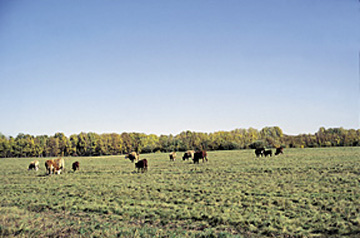
Figure 7. Grazing creeping red fescue seed fields in the fall.
Endophytes
Health problems may occur if livestock are fed straw, seed screenings or the re-growth of certain turf grass species that contain endophytes. Endophytes are fungi that can be toxic to livestock and that live within the plants. They are transmitted by fungal strands in the seed, and they generally increase the vigor of infected plants by making them more tolerant to drought, insects, diseases, grazing and physical damage.
Endophytes can be found in a number of grass species, including fine-leaved fescues, but the species with the highest risk to livestock producers are turf type tall fescue and perennial ryegrass varieties.
Turf grass breeders want high levels of endophytes in varieties they develop because the fungi are very beneficial in a turf stand (Figure 8). On the other hand, breeders developing grasses for forage and livestock production select for low levels or the absence of endophytes.
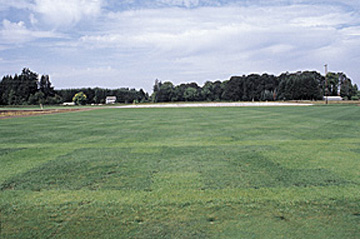
Figure 8. Turf type grass seed varieties are bred for increased endophyte levels (picture of tall fescue turf grass variety trial).
Endophytes produce several toxins classified as ergot alkaloids. Commonly identified endophytes harmful to livestock include ergovaline (found in tall fescue or fine-leaved fescue varieties) and Lolitrem B (found in some perennial ryegrass varieties).
Effects of ergovaline on livestock:
- lower feed intake (resulting in poor performance or weight loss)
- lower pregnancy rates
- decreased milk production
- a condition known as fescue foot that occurs when ergovaline constricts blood flow to the extremities (feet, tail and ears) and in winter, causes severe swelling and frostbite
Lolitrem B can cause ryegrass staggers; however, animals do not show signs of the condition until they are excited. Animals can experience problems ranging from tremors to severe lack of coordination and falling down.
Horses are considerably more sensitive to alkaloids than are ruminants. If grass seed straw with high levels of ergovaline or Lolitrem B is being fed to pregnant mares, the material should be removed from their diet 60 to 90 days before foaling to negate any problems.
Reproductive problems in horses caused by alkaloids include the following:
- agalactia (mare has no milk production after giving birth)
- thick placentas
- spontaneous abortions
- dead or weak foals at birth and rebreeding problems
Endophyte-infected tall fescue or perennial ryegrass pastures, hay, seed screenings and straw should not be fed to horses.
More facts about endophytes:
- They can only be transmitted by infected seed; an endophyte-free plant cannot become infected even though the plant right beside it has the endophyte.
- Seed can be tested for endophyte levels before seeding, and seed companies should be able to provide this information.
- Knowing endophyte levels in the seed will only provide a guideline as to whether a producer should be concerned about the level of endophyte toxin that could show up in straw, re-growth or seed screenings.
- Endophyte levels in the seed do not always indicate what the concentrations of ergovaline will be in the forage material.
- A seed lot that tests free of endophytes will produce forage that is also free of the fungus.
- The percentage of endophytes in the seed of different tall fescue and perennial ryegrass varieties is listed at the following website.
- Screenings from endophyte-infected tall fescue and perennial ryegrass are particularly high in ergovaline or Lolitrem B and should not be fed to livestock.
- Feed should be tested if there are any safety concerns regarding the endophyte level. Once levels are known, the feed can be mixed with other feed sources to reduce risk.
Testing for ergovaline and Lolitrem B in grass seed straw, fall re-growth or seed screenings can be done by sending feed samples to:
Oregon State University
Veterinary Diagnostic Lab
30th and Washington Way
Magruder Hall
Corvallis, Oregon 97331
Phone: (541) 737- 6541
Experiments and case studies conducted at Oregon State University and elsewhere have established the threshold levels in the diet at which ergovaline and Lolitrem B produce clinical disease (Table 12). Threshold levels vary depending on enviromental conditions and the amount of stress animals are under.
| Table 12. Threshold levels of ergovaline and Lolitrem B in the diet that produce clinical disease |
| Livestock | Ergovalineparts per billion (ppb) | Lolitrem Bparts per billion (ppb) |
| Horses | 300 - 500 | Not determined |
| Cattle | 400 - 750 | 1,800 - 2,000 |
| Sheep | 800 - 1,200+ | 1,800 - 2,000 |
A survey was conducted in the Peace Region on ergovaline levels in tall fescue and fine-leaved fescue straw, re-growth and seed.
Turf type fine-leaved fescue varieties may also have endophytes present, but the levels of ergovavaline found in the straw have been minimal.
Summary
Grass seed straws are effective feed alternatives for reducing ration costs for cows in the second to early third trimester. Depending on feed quality, straws are best suited for mature cows that have good body condition scores. Using straw rations for growing and/or thin animals will result in animals that are nutritionally deprived, which may affect calving and re-breeding success.
When using grass seed straw as feed, consider the following:
- Take the time to ensure rations are balanced.
- Pay careful attention to the levels of digestible intake protein and minerals.
- Remember that once the cows have calved, the proportion of the grass seed residues in the ration will have to be reduced to meet the cow's increased energy and protein requirements.
- Work with a nutritionist or local feed company to get a better idea of the proportion that can be included.
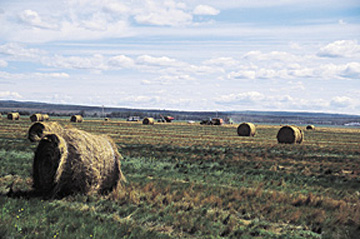
Figure 9. Creeping red fescue straw bales in the Peace River region.
References
Aldrich-Markham, S., and G.Pirelli. 1995. Endophyte toxins in grass seed fields and straw. Oregon State University Extension Service, Corvallis, OR. EM 8598
Yoder, C., and Fournier B. 2002. Survey of endophyte content of turf grass seed stands in the Peace River Region. 6 pp.
Yoder, C. 2005. Survey of feed value of grass seed aftermath in the Peace River Region. 4 pp.
Yurchak, T. 2003. Beef Cow Body Condition Management. Alberta Agriculture Food and Rural Development. Agdex 420/40-3. 3 pg.
Prepared by:
Calvin Yoder - Forage Seed Crops Agrologist, Alberta Agriculture and Forestry
Christoph Weder - SVR Ranch Consulting
Technical input and review
Arvid Aasen - formerly with Alberta Agriculture and Forestry
Gary Ropchan and Melissa Fuchs - Central Peace Conservation Society
Henry Najda - formerly with Alberta Agriculture and Forestry
Julie Robinson - Forage Technician, B.C. Peace Forage Association
Mark Johns - formerly with Alberta Agriculture and Forestry
Sandra Burton - Manager, Peace Region Forage Seed Association
Funding provided by
Source: Agdex 420/68-1. October 2005. |
|